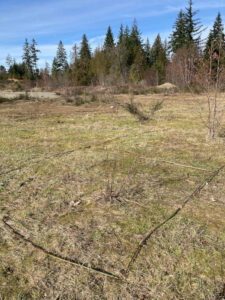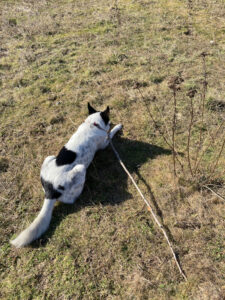I collected my data on Monday 19 Feb 2024. The day was around 7°C, sunny with clouds and a light breeze. I started collection at 11.40am and finished at 1.35pm. In total I collected 16 replicates.
In the field the data collection went smoothly and according to the sampling design submitted in a previous step. By the end of the sampling two of the boundary sticks that I was using to help section my large plot were damaged, and I had to eyeball the boundary edges for those two sections.


The second half of the sampling, towards the back of the sample site, went quicker as when I stood at the location that would be the midpoint of my sectioned plot it was obvious there were no plants of either of Species #1 or Species #2 that would be within 10 m distance of my midpoint in any direction. For these samples I did not fully lay out all of the boundary sticks to save time, and I marked on in my field journal which of the plot boundaries had been eyeballed.
The greater problem became apparent on getting home and uploading the data. I had been using Google maps to ‘drop a pin’ at each sample plot midpoint as I had been sampling. Unfortunately the cell service was not great, and coupled with the lower precision of an iPhone, over a dedicated GPS unit, it turned out the sample coordinates were of no use. Below are pictures of the sample locations per Google maps (yellow pins), versus where I believe the samples were taken based on my field notes and memory of the direction I walked between each sample (green pins).


I have not yet looked closely at the data I collected, but I did notice while in field that there were more instances of both species near the front of the sample site (nearer the road) than towards the back (near the undisturbed area). On first glance, the data appears to confirm my hypothesis that the species grow in close proximity to each other.
yes, the research assistant chewing sticks is always a problem!
note that the plots can be selected to include the species of interest, or the plots can be chosen to include representative areas ecologically (which may or may not include individual species)
interesting notes on the GPS variation